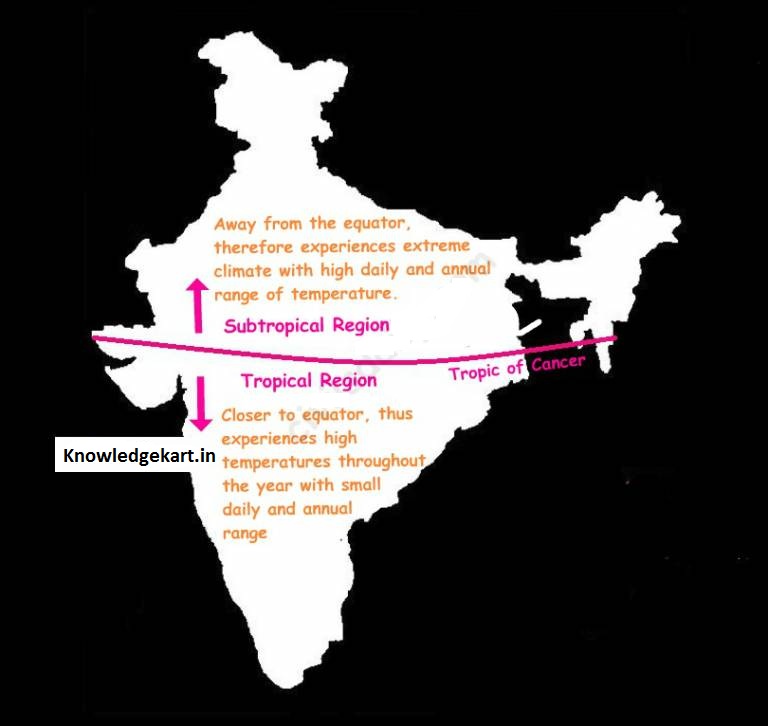Climate of India Geography. India’s climate can be described as hot monsoonal type. The word monsoon comes from the Arabic word ‘Mausim’ which means ‘season’. Monsoon, by definition, is a wind system that changes wind direction seasonally. The four principal monsoon regions in the world are:
- South Asia
- East Asia
- Northern Australia
- West Africa
Let’s take the case of South Asia:
During winter, the large continent of Asia gets extremely cold and the Siberian high pressure develops. Air flow is offshore and dry. During the summer, the continent develops low pressure in response to heating and the airflow reverses. Moisture-laden air from the ocean is brought inland where it rises over the terrain and produces extremely large amounts of rainfall. See the following diagram and observe the marked shift in the wind direction.

But at the same time, we know that there are great regional differences and variations experienced in India with respect to temperature rainfall etc. Let’s look at some of these regional variations:
- Variations in temperature: While in the summer the mercury occasionally touches 55°C in the western Rajasthan, it drops down to as low as minus 45°C in winter around Leh. On a December night, the temperature in Drass (Jammu and Kashmir) may drop down to minus 45°C while Thiruvananthapuram or Chennai on the same night record 20°C or 22°C.
- Daily temperature range: In Kerala and in the Andaman Islands, the difference between day and night temperatures may be hardly seven or eight degree Celsius. But in the Thar desert, if the day temperature is around 50°C, at night, it may drop down considerably up to 15°-20°C.
- Regional variations in type and amount of precipitation: While snowfall occurs in the Himalayas, it only rains over the rest of the country. Similarly, while Cherrapunji and Mawsynram in the Khasi Hills of Meghalaya receive rainfall over 1,080 cm in a year, Jaisalmer in Rajasthan rarely gets more than 9 cm of rainfall during the same period. Most parts of the country get rainfall during June-September, but in the coastal areas of Tamil Nadu, it rains in the beginning of the winter season.
These regional variations differentiate the weather and climate of different regions of India.
This brings us to the difference between weather and climate:
Weather is the momentary state of the atmosphere while climate refers to the average of the weather conditions over a longer period of time. Weather changes quickly, maybe within a day or week but climate changes imperceptive and may be noted after 50 years or even more.
Factors Determining the Climate of India:
India’s climate is controlled by a number of factors which can be broadly divided into two groups — factors related to location and relief, and factors related to air pressure and winds.
Factors related to Location and Relief
1. Latitude: The Tropic of Cancer passes through the central part of India in the east-west direction. Thus, the northern part of the India lies in the sub-tropical and temperate zone and the part lying south of the Tropic of Cancer falls in the tropical zone. The tropical zone being nearer to the equator experiences high temperatures throughout the year with small daily and annual range. Areas north of the Tropic of Cancer being away from the equator, experience extreme climate with high daily and annual range of temperature.

1. The Himalayan Mountains:
The lofty Himalayas in the north along with its extensions act as an effective climatic divide.
- The Himalayas act as an invincible shield to protect the subcontinent from the cold northern winds. These cold and chilly winds originate near the Arctic Circle and blow across central and eastern Asia.
- The Himalayas also trap the monsoon winds, forcing them to shed their moisture within the subcontinent.
3. Distribution of Land and Water: India is flanked by the Indian Ocean on three sides in the south and girdled by a high and continuous mountain-wall in the north. As compared to the landmass, water heats up or cools down slowly. This differential heating of land and sea creates different air pressure zones in different seasons in and around the Indian subcontinent. The difference in air pressure causes a reversal in the direction of monsoon winds. Climate of India
4. Distance from the Sea: With a long coastline, large coastal areas have an equable climate. Areas in the interior of India are far away from the moderating influence of the sea. Such areas have extremes of climate. That is why the people of Mumbai and the Konkan coast have hardly any idea of extremes of temperature and the seasonal rhythm of weather. On the other hand, the seasonal contrasts in weather at places in the interior of the country such as Delhi, Kanpur and Amritsar affect the entire sphere of life.
5. Altitude: Temperature decreases with height. Due to thin air, places in the mountains are cooler than places on the plains. For example, Agra and Darjeeling are located on the same latitude, but the temperature of January in Agra is 16°C whereas it is only 4°C in Darjeeling. Climate of India
6. Relief: The physiography or relief of India also affects the temperature, air pressure, direction and speed of the wind and the amount and distribution of rainfall. The windward sides of Western Ghats and Assam receive high rainfall during June-September whereas the southern plateau remains dry due to its leeward situation along the Western Ghats. Climate of India
Factors Related to Air Pressure and Wind
The following three factors are responsible for the differences in local climates of India:
- Distribution of air pressure and winds on the surface of the earth.
- Upper air circulation caused by factors controlling the global weather and the inflow of different air masses and jet streams.
- The inflow of western cyclones generally known as disturbances during the winter season and tropical depressions during the south-west monsoon period into India. Climate of India
Note: The variations in the atmospheric pressure closer to the surface of the earth have no role to play in the making of upper air circulation.
The mechanism of these three factors and their impact on the Indian climate will be understood with reference to specific seasons of the year in the following sections. Climate of India
India’s Climatic Calendar
The climatic conditions of India can best be described in terms of an annual cycle of seasons.
The India Meteorological Department (IMD) recognises the following four seasons:
- The Winter Season (January – February)
- The Pre-monsoon Season or summer season (March – May)
- The Southwest Monsoon Season or rainy season (June – September)
- The Post Monsoon Season or autumn season (October – December)

- India’s Climatic Calendar
India’s climate is a crucial aspect of its geography, influencing various aspects of life and development. Understanding India’s climate is essential for the UPSC IAS exam, as it touches on multiple facets of geography, environmental science, and socio-economic impact. This article provides a detailed overview of India’s climate, focusing on its types, variations, and implications.
1. Overview of India’s Climate
India experiences a diverse range of climatic conditions due to its vast size and geographical features. The climate of India can be broadly categorized into four main types:
- Tropical Rainforest Climate (Equatorial Climate)
- Tropical Monsoon Climate
- Subtropical Climate
- Temperate Climate
2. The Major Climatic Zones of India
2.1. Tropical Rainforest Climate
This climate is primarily found in the Andaman and Nicobar Islands, the western coast, and parts of northeastern India. Characterized by high temperatures throughout the year and heavy rainfall, this zone experiences no distinct seasonal variations. Rainfall exceeds 2000 mm annually, supporting dense forest vegetation.
2.2. Tropical Monsoon Climate
The tropical monsoon climate covers most of India and is divided into two main sub-types:
- Southwest Monsoon Region: This includes the western coast and northeastern India. It experiences heavy rainfall from June to September due to the southwest monsoon winds. Rainfall ranges between 800 mm and 2500 mm.
- Northeast Monsoon Region: This zone covers parts of the eastern coast and receives rainfall from October to December. It generally receives moderate rainfall, between 600 mm and 1000 mm.
2.3. Subtropical Climate
Found in the northern plains and parts of the central India, this climate features hot summers, cold winters, and moderate to low rainfall. The annual rainfall ranges between 400 mm and 1000 mm, with significant temperature variations between summer and winter.
2.4. Temperate Climate
This climate is present in the Himalayan region, where temperatures are moderate to cold throughout the year. The region experiences heavy snowfall during the winter months and moderate rainfall during the monsoon season. This zone is crucial for understanding the impact of climate on high-altitude environments.
3. The Monsoon System
The Indian monsoon system is one of the most significant climatic phenomena. It is characterized by the seasonal reversal of winds and affects the entire subcontinent. The monsoon system comprises:
- Southwest Monsoon: Originating from the Indian Ocean, it brings substantial rainfall to most parts of India from June to September.
- Northeast Monsoon: Influences the southeastern coast and the southern peninsula, particularly during October to December.
4. Factors Influencing Indian Climate
Several factors influence India’s climate:
- Latitude: India’s location between the Tropic of Cancer and the Equator affects its temperature and seasonal variations.
- Altitude: The Himalayas play a significant role in shaping the climate by blocking cold winds from Central Asia and influencing rainfall patterns.
- Distance from the Sea: Coastal areas experience a maritime climate with moderate temperatures, while inland regions experience more extreme temperatures.
- Pressure Systems: The Indian subcontinent’s climate is also influenced by various pressure systems, including the Indian Ocean Dipole and El Niño-Southern Oscillation. Climate of India Geography
5. Impact of Climate on India
India’s climate has a profound impact on its agriculture, economy, and daily life:
- Agriculture: The monsoon is critical for agriculture, affecting crop yields and food security. Variability in rainfall can lead to droughts or floods, impacting farming communities.
- Economy: Climate patterns influence sectors like water resources, energy, and tourism. For example, the availability of water for irrigation and hydropower generation is directly linked to monsoon rainfall.
- Health: Climate affects health outcomes, with temperature extremes contributing to heat strokes and cold-related illnesses. Monsoon-related flooding can also lead to waterborne diseases. Climate of India Geography
6. Challenges and Adaptations
India faces several climate-related challenges, including:
- Climate Change: Increasing temperatures, shifting monsoon patterns, and rising sea levels pose risks to agriculture, coastal areas, and biodiversity.
- Extreme Weather Events: The frequency of extreme weather events, such as cyclones and heatwaves, has increased, affecting infrastructure and human lives.
Adaptation measures include improving water management, developing climate-resilient crops, and enhancing disaster preparedness. Climate of India Geography
7. Conclusion– Climate of India Geography
Understanding the climate of India is essential for comprehending its geographical and environmental dynamics. For UPSC IAS aspirants, a thorough grasp of India’s climatic zones, monsoon systems, and their socio-economic impacts is crucial for both the prelims and mains exams. By integrating this knowledge with current issues related to climate change and adaptation strategies, candidates can develop a well-rounded perspective on India’s climatic challenges and opportunities. Climate of India Geography
That’s it for this part. In the next post, we will continue the discussion with the Winter Season i.e. the period from January – February! UPSC Climate of India
Read Other Important Articles for UPSC IAS Click Here
Monsoon of South Asia Climate and Indian Geography Most Important Topic
Pre Monsoon Season Indian Climate UPSC
Indian Monsoon Factors & Theories
Climate of India For UPSC IAS 2022.A Topic of Indian Geography & G.K
